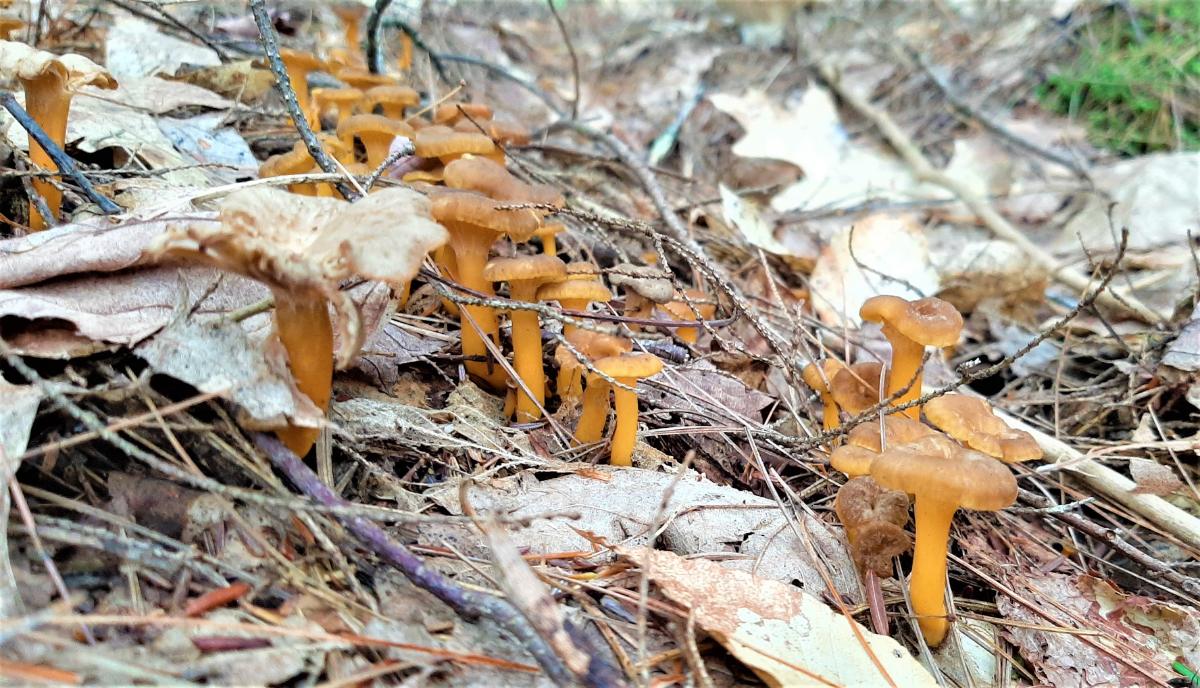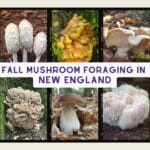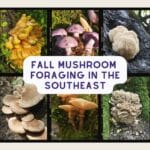Winter is usually a sad time for mushroom foragers. The weather is too cold for most fungi to appear, so there isn’t much reason to go out in the woods. But there’s some good news. Winter mushroom foraging is a thing! There may not be much out there, but if you know what to look out for, you could be blessed by the winter mushroom gods.

Jump to:
The Guide to Regional Winter Mushroom Foraging
This guide to winter mushroom foraging divides the United States into very broad regions. There, of course, will be variance among areas, but it’s a good basic guide to follow. The reason for the division is that northern and southern states experience vastly different weather conditions in winter. And, because the Pacific Northwest is basically a beast unto its own and completely different from both the north and south. After reading this, you might find yourself researching plane tickets to the PNW for the winter!

Winter Mushroom Foraging in Northern States
This general range includes the upper midwest, New England, and basically anywhere that gets snow dumped on it in large amounts. The mushrooms that grow during this time are hardy species, to be sure, just like the folks living there.
It’s best to taper expectations if you live in any snowy winter wonderland. Yes, fungi are growing out there, but finding them takes tons of patience, a hardy temperament to deal with the cold, and a bit of luck. Most of the species that survive cold temperatures grow from wood or living trees, so don’t worry about digging through the snow in search of mushrooms. Mostly, you just need to look around while out in the forests.
Fungi rarely emerge through frozen wood, so once it’s super cold or below freezing all day long, it’s unlikely new mushrooms will appear. If you get a mid-winter thaw or rain, that’s a good time to go out looking.

- Chaga – Chaga grows on birch trees, and winter is one of the best times to hunt it because there aren’t leaves or foliage blocking your view. Winter is also the best time to harvest chaga because the tree is dormant, so you don’t have to worry about damaging its growth as you harvest.
- Turkey Tail – Turkey tail grows year-round, seemingly unconcerned with seasons. It is a small bracket mushroom that remains viable for a long time. So, even if it’s not actively growing, you may find growth from earlier in the season that is still good to harvest.
- Witches’ Butter – It’s hard to miss the goopy, gloppy bright orange-yellow fruiting bodies of witch’s butter, especially in contrast to a snowy background. Witch’s butter adds a great texture to winter soups and stews.
- Velvet Foot Enoki – Literally known as “the winter mushroom,” wild enoki thrives in cold weather. It’s not uncommon to find them slightly frozen or with a dusting of snow. Be super careful with this one, as it has some troublesome lookalikes.
- Wood Ear – This brown ear-shaped jelly fungus isn’t always easy to see since it blends in really well. Wood ear mushrooms don’t deteriorate very quickly, so there’s a good chance of finding some excellent specimens.
- Birch Polypore – Like Chaga, this birch tree fungus is also common in winter. It prefers dead and dying birch trees, so look for those struggling trees. Birch polypore isn’t for eating, but it is an excellent medicinal mushroom.
- Late Fall Oysters – This greenish mushroom that is not actually an oyster mushroom species is super cold and hardy. This forager has literally found and foraged frozen specimens off trees in January. Too much freezing and thawing cause the mushrooms to deteriorate badly, but if you catch them just right, it’s a great, hearty mushroom find.
- Amber Jelly Roll – This squishy brown fungus loves the cold. Its brown coloring blends into the dead logs and branches it is growing on, so it can be hard to spot.
- Brick Caps – This abundant mushroom species starts appearing in late fall and will continue fruiting until the snow falls. Or until it is continuously cold for a long time. It is common to find them through November and often into December. Once there is significant snow, the season is done for these guys.

Winter Mushroom Foraging in Southern States
These regions are loosely defined as places that don’t receive boatloads of snow in winter. Most areas of the southern United States get cold and freezing temperatures throughout parts of the winter, but not for overly extended periods of time. For many mushrooms, this is prime fruiting weather. Cold, but not so cold that they hide away. Winter mushroom foraging in the south and southwest is usually not to bad in winter.

- Lion’s Mane – One of the great things about lion’s mane being a late fall/winter mushroom is that it’s easier to see when there are no leaves on the trees. The bright white spines stand out strongly in a stark, gray landscape.
- Brick Caps – Brick caps adore cool weather but don’t like snow, which makes the not-too-cold southern states ideal. They’re often found in dense quantities around dead stumps.
- Wood Blewit – The wood blewit appears only after the summer heat is gone. It is not uncommon to find this striking mushroom in the middle of winter, even when the weather is very cold.
- Oysters – True oyster mushrooms are a cold-weather species. As long as there are no long extended periods of freezing temps, you can potentially forage oyster mushrooms all winter season. They might freeze on the tree, but as long as you catch them before they thaw and begin decomposing, they’ll still be good eating.
- Velvet Foot Enoki – Wild enoki don’t look anything like their cultivated cousins. Keep an eye out for this winter mushroom all season long; it isn’t known as “the winter mushroom” for nothing.
- Witches’ Butter – Bright yellow-orange jelly-like blobs are hard to miss, making witch’s butter an easy winter mushroom to see.
- Wood Ear – This excellent edible mushroom with a weird ear shape grows all winter long. It’s excellent in brothy soups and stir-fries.

Winter Mushroom Foraging in The Pacific Northwest
Winter mushroom foraging in the Pacific Northwest differs from other parts of the country. In many areas, it doesn’t really snow; it just rains a lot. And mushrooms LOVE rain, even if it’s a cold, drizzly type of rain. Of course, some areas get snow and a lot of it; there are many variances. Usually, you just have to change elevations a little bit to increase your chances of finding edible mushrooms. Often, along the coast is excellent foraging year round due to the lack of snowfall and abundant rains.

- Winter chanterelles (yellowfoot) – This relative of the chanterelle grows in vast, dense patches. It’s easy to harvest bucketfuls when you find them. They prefer mossy areas with lots of rich, decaying organic material.
- Black Trumpets – The black chanterelle isn’t the easiest mushroom to forage due to its frustrating ability to blend in with its surroundings. However, they also grow in giant patches, so when you do find them, it’s like hitting the jackpot!
- Lion’s Mane – Lion’s mane like cool weather but not long-term freezing temperatures or snow. Look for the classic lion’s mane as well as the other related Hericium species; they’re all edible and a real score to find.
- Hedgehogs – These cute mushrooms with teeth instead of gills are top in most foragers’ lists of edibles. Their dense flesh and sweet flavor are exquisite. Hedgehogs look rather dull from the top, a flat tannish color that is easy to miss if you’re not paying attention. Make sure you’re paying attention!
- Truffles – Truffle season is from late December into March or April, depending on where you live in the PNW. Three types of truffles grow in the PNW, associated with Douglas firs in winter. Truffle hunting takes some skill and possibly an extraordinary dog – it’s a great winter hobby to take up! [Do you know about the Oregon Truffle Festival?!?!]
- Candy Caps – This sweet maple-syrup-smelling mushroom is such a treat to find. Candy caps are a type of milky cap mushroom, and they love the cool, rainy winters of the PNW.
- Wood Blewit – Keep your eyes peeled for this purple mushroom; it tends to fruit in great numbers and is a highly sought-after edible species. They may appear all season long in milder climates.
- Oysters – Oyster mushrooms tend to wait for the weather to cool down before fruiting. They don’t mind some freezing weather. The only problem is getting to them before the hungry slugs and bugs do!

Wintertime Alternatives For Mushroom Fanatics
As you can see, winter mushroom foraging can still bring up some gems! However, even with all these species, it can be slim pickings. Or, just too cold and miserable to go outside and even look. Don’t fret, though. You can still have mushrooms in your life even when the weather isn’t working in your favor.
Winter is an excellent time to try out some in-home Mushroom Growing Kits or brush up on your identification skills so you’ll be in top form come spring.










Leave a Reply